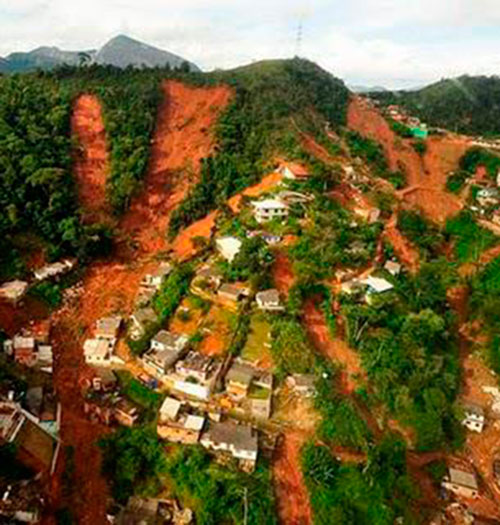|
Brazil Flood Disaster: January, 2011 Torrential rains and massive floods devastated a wide mountainous region near Rio de Janeiro , Brazil in mid-January, 2011. (" Rio de Janeiro" means "River of January" in Portuguese.) The scale of this tragedy has been compared to the Katrina hurricane in the US Gulf states in 2005.
As the son of this land, a “serrano” citizen, born and raised in the mountains, a lover of the mountains, mountaineer and environmentalist, never in my life have I seen something like what happened. I've seen numerous landslides, including ones in areas of dense forest. I witnessed the power of the waters in the mountains of this area. At one time, in a place where there was a small stream where I used to bathe, the area turned into a wide canyon of rocks and twisted trunks. There, in those very woods. These events are common, and yes, even healthy for nature. They are part of the dynamics of renewal of these forests. When a gap opens in the forest, a cycle of renewal begins and new growth comes, attracting more animals and giving opportunities to other plants to fulfill their role in nature. These cycles are beautiful to watch. It turns out that even in the biggest of what I've seen happen one time or another, every few years, these are occurrences that happen separated by miles. This time, what I witnessed were landslides everywhere, in all the mountains where the rain fell. All, absolutely all that is there has some area where cover crops and green has been washed away. The mountains bleed. I felt in my chest the pain they feel. In this huge area, covering several square miles, encompassing 6 counties, there is no place where you do not see a huge landslide.
What happened was a phenomenon too grand to be treated as common, and to receive simplistic explanations based on previous phenomena. This needs to be studied and understood more carefully and more accurately. Say what you want, but it is clear to me; I know these mountains and call them by name. They have suffered. They are torn. For me, it's like I can hear and feel their vibrations, the mountains are calling, asking for help, because they're no longer supporting. The landscape has changed and is likely to continue changing. An abrupt change. Certainly, this phenomena is related and associated with effects of global warming. Is it just one of the many major natural disasters that we will see as we move forward. To treat it like it is a common occurrence is to belittle, or diminish the pain that these hills are feeling. It is ignoring the cry of the Earth. We have already made too many mistakes. We can no longer stop global warming, or hope to reverse it. As we move forward, we will pay the price. But I hope that men may learn the lesson that we are all connected, that we still know very little about nature of which we are part of, and that we are not all that is here, as humanity has wanted to think we are. We must look at the example of our ancestors and their "primitive" cultures, and re-learn to respect and have awe for nature. Nature must again be revered. The notion the sacredness of nature urgently needs to be restored. Not so we may worship gods and goddesses, but so we may appreciate and recognize, and perhaps understand, our ONENESS with all creation. José Francisco Matulja
|

To install this Web App in your iPhone/iPad press ![]() and then Add to Home Screen.
and then Add to Home Screen.
 José Francisco Matulja is an environmentalist who leads people in walks and photo expeditions so they may rediscover their oneness with Nature. Please read his moving testimony about the January floods, as translated by
José Francisco Matulja is an environmentalist who leads people in walks and photo expeditions so they may rediscover their oneness with Nature. Please read his moving testimony about the January floods, as translated by

